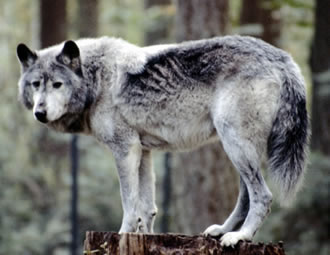| |
|
 |
|
 |
Carnivora (carnivores)
Carnivora
Most carnivores are meat eaters. Their jaws only move vertically, or up and down. Most carnivores have sharp side teeth, or canines, that help them sever meat. Most species in this order are land animals, but the pinnipeds live in the ocean. This order is very diverse. Animals in this order include wolves, lions, bears, raccoons, sea lions, seals, walruses, weasels, skunks, otters, badgers, civets, mongooses, and hyenas. There are over 260 mammals in this order in 13 families.

|
|
 |
Key:  Article Article  Photos Photos  Video Video  Audio Audio |
 Vulnerable Vulnerable  Endangered Endangered  Critically Endangered Critically Endangered  Extinct in the Wild Extinct in the Wild  Extinct Extinct
Status taken from ICUN Redlist |
| |
| Carnivora Families |
|
 Ailuridae (red panda) Ailuridae (red panda)
 Canidae (coyotes, dogs, foxes, jackals, wolves) Canidae (coyotes, dogs, foxes, jackals, wolves)
 Mephitidae (skunks, stink badgers) Mephitidae (skunks, stink badgers)
 Mustelidae (badgers, otters, weasels) Mustelidae (badgers, otters, weasels)
 Odobenidae (walruses) Odobenidae (walruses)
 Otariidae (fur seals, sea lions) Otariidae (fur seals, sea lions)
 Phocidae (seals) Phocidae (seals)
 Procyonidae (coatis, raccoons) Procyonidae (coatis, raccoons)
|
 Ursidae (bears) Ursidae (bears)
 Eupleridae (Malagasy carnivores) Eupleridae (Malagasy carnivores)
 Felidae (cats) Felidae (cats)
 Herpestidae (mongooses) Herpestidae (mongooses)
 Hyaenidae (aardwolf, hyenas) Hyaenidae (aardwolf, hyenas)
 Nandiniidae (African palm civet) Nandiniidae (African palm civet)
 Viverridae (civets, genets, linsangs) Viverridae (civets, genets, linsangs)
|
Carnivora Resources |
|
 Lesson Plans Lesson Plans
 Games/Interactives Games/Interactives
 Video Video |
|
|
Websites
Order Carnivora  
There are around 270 species in this order.
Source: Animal Diversity Web Intended Audience: General Reading Level: Middle/High School Teacher Section: No Searchable: Yes
Order Carnivora  
This order is very diverse. Animals in this order include wolves, lions, bears, raccoons, sea lions, seals, walruses, weasels, skunks, otters, badgers, civets, mongooses, and hyenas.
Source: NHPTV Wildlife Journal Junior Intended Audience: Students Reading Level: Elementary/Middle School Teacher Section: Yes Searchable: No
Carnivores  
Carnivores are predators. They hunt and eat other animals to survive. Mammals that are carnivores have sharp teeth adapted for ripping meat from a carcass.
Source: NHPTV Wildlife Journal Junior Intended Audience: Students Reading Level: Elementary/Middle School Teacher Section: Yes Searchable: No
Introduction to the Carnivora  
Most carnivores are land animals, but an important and highly specialized group of carnivores, the pinnipeds or "fin-feet," have taken up life in the oceans.
Source: University of California Museum of Paleontology Intended Audience: General Reading Level: Middle/High School Teacher Section: No Searchable: Yes
Otters   
Otters spend a lot of time in the water! they have long, streamlined bodies and flattened tails that help the dive and maneuver in the water. Learn more!
Source: San Diego Zoo Intended Audience: Students Reading Level: Elementary/Middle School Teacher Section: Yes Searchable: Yes |

Animal Diet Game
Can you identify an animal by whether it is an herbivore, omnivore, or carnivore?
Food Chain Game
What eats what? Play the food chain game and find out.
Wolf Quest
Learn about wolf ecology by living the life of a wild wolf in Yellowstone National Park. Play alone or with friends in on-line multiplayer missions, explore the wilderness, hunt elk, and encounter stranger wolves in your quest to find a mate. |
|
Online Video

Lone Wolves - Grades 6-12
Students learn about controversy in the northern Rockies to delist wolves as an endangered species. They then take part in an in-class debate on the subject. Source: NY Times
Who's Afraid of the Reintroduced Wolf? - Grades 6-12
In this lesson, students investigate the impacts of the reintroduction of animal species to the animals' natural habitats, the animals themselves and humans. Source: NY Times
Wolf Habitat
Students investigate what a wolf need in a habitat to survive. Source: Glacier National Park
Wolves at Our Door - Grades 6-8
Students look at the similarities exist between a wolf pack and a human family or social group. Source: Discovery Education
Return of the Wolf
Teaching ideas focuses on the wolf. Source: Education World
The Big, Bad Wolf...Is This a Fact?
Students read Wolves by Seymour Simon and create presentations based on their reading.
Source: Read Write Think
From Wolf to Woof - Grades 6-8
Students investigate the process of dog domestication. Source: National Geographic
Life Within the Pack - Grades K-4
Students investigate the structure and role of wolf packs. Source: Northland College
Wolf Lesson Plan - Grades 2-4
Students learn about wolves and why they are important to the ecosystem Source: Wolf Song of Alaska
Wonderful Wolves - Grades 3-5
students learn about wolves through literature and research. Students learn the truth about wolves by completing a WebQuest examining wolf myths. Source: Alabama Learning Exchange
Introduction to Wolves and Coyotes - Grades 1-3
Students use the internet to investigate wolves and coyotes. Source: Amphitheater School District
Nocturnal Animals: Skunks - Grades K-3
In this lesson students will learn interesting facts about skunks. They will also design a "nose guard" that people can wear to protect themselves against the smell of a skunk. Then students will have a chance to dramatize a commercial for their "nose guards."
Source: Alabama Learning Exchange |
|
|
|
|
|
|
| |
|
|